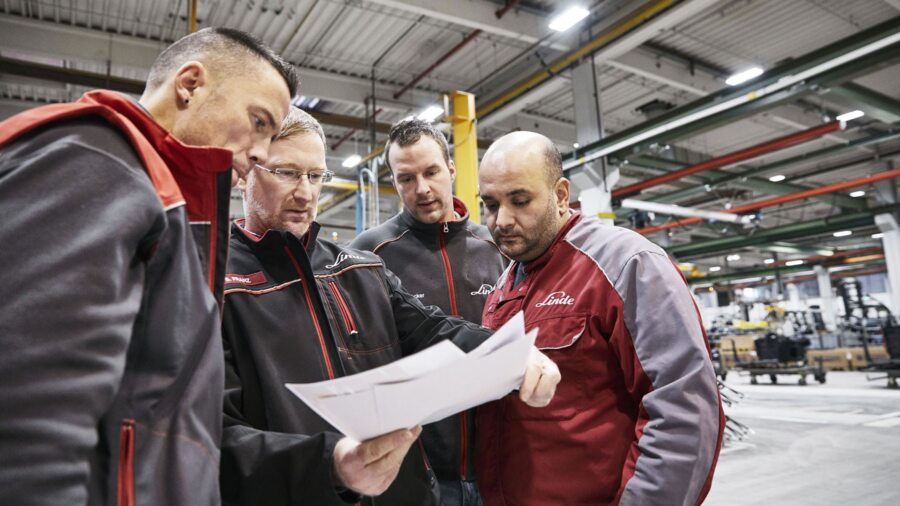Targets and Key Figures

Selected Sustainability-related Key Figures
All key figures and data can be found in the relevant chapters.
| Environment | 2022 | 2021 | 2020 |
|---|---|---|---|
| ISO 14001 certification rate1 | 85% | 81% | 75% |
| Energy consumption | 1,079,340 GJ | 1,143,040 GJ | 882,211 GJ |
| Greenhouse gas emissions (Scope 1 and 2)2 |
63,286 t CO2e | 67,003 t CO2e | 60,404 t CO2e |
| Greenhouse gas emissions (Scope 3.3)2 | 15,626 t CO2e | 16,173 t CO2e | 13,580 t CO2e |
| Water withdrawal | 140,942 m3 | 153,409 m3 | 105,818 m3 |
| Waste produced | 25,245 t | 28,687 t | 15,296 t |
| Employees | 2022 | 2021 | 2020 |
|---|---|---|---|
| Percentage of female employees | 17% | 17% | 16% |
| ISO 45001 certification rate1 | 82% | 74% | 59% |
| LTI (Lost Time Injuries)3 | 208 | 255 | 190 |
| Accident frequency rate4 | 9.5 | 11.9 | 10.9 |
[1] Or equivalent standards, based on all sites.
[2] Greenhouse gas emissions in kilograms CO2 equivalent, Scope 1 and 2 market-based, Scope 3.3 location-based.
[3] Occupational accident with at least one day of absence.
[4] Occupational accidents involving active employees with lost time of at least one working day, per million hours worked.
Key Targets
Linde Material Handling’s sustainability targets are aligned with the key targets of the KION Group’s sustainability strategy, which covers not just the individual measures taken by the organizational units but the efforts of the entire Group.
| Dimension | Field of action | Objectives | Target year |
|---|---|---|---|
| People | Occupational health and safety | Reduction of the accident frequency rate by 5% per year (based on the annual upper limit; in the long term: no occupational accidents) | Annual |
| 100% ISO 450011 certification rate (all sites) |
2024 | ||
| Talent | Increase in employee satisfaction to an engagement score of at least 75 and a participation rate of at least 68%, as measured by an annual, global employee survey | 2023 | |
| No cases of non-compliance with the KION Group Minimum Employment Standards | Ongoing | ||
| Products | Product and solution sustainability | Development toward an electric-focused portfolio, including battery and fuel cell-powered products, by increasing the share of electrically powered trucks sold annually to 90% | 2027 |
| Increase in average charging efficiency of electrically powered trucks | 2027 | ||
| Product and solution safety | Increase in the average number of selected safety features per industrial truck to 4 and an active safety feature equipment rate of 10% | 2027 | |
| Processes | Climate and energy | Absolute reduction of GHG emissions (Scope 1, 2, 3) in tons of CO2e compared to 20212 | |
Scope 3 by 2.5% per year |
2030 | ||
|
By 2050 | ||
| CO2 neutrality of products and solutions during the use phase (in tons of CO2e Scope 3 GHG emissions caused by the use of products and solutions delivered annually) | By 2050 | ||
| 30% absolute reduction of total energy-related GHG emissions from own operations in tons of CO2e (Scope 1, 2, 3.3) compared to 2017 | 2027 | ||
| 100% ISO 140011 certification rate | 2024 | ||
| Circularity | In progress | ||
| Supply chain | EcoVadis score or Equivalent rating3 (corporate social responsibility performance) available for: | ||
| 25% of top spend on strategic suppliers | 2022 | ||
| 100% of strategic and high-risk suppliers4 | 2023 | ||
| 100% of direct suppliers | 2025 | ||
| Definition and communication of a minimum EcoVadis score3 (or equivalent rating) for all suppliers | 2023 | ||
| Minimum EcoVadis score mandatory for all suppliers | 2027 | ||
| Sustainable governance | EcoVadis “Gold” rating for all Operating Units and the KION Group | 2027 | |
| S&P Global Corporate Sustainability Assessment (CSA), KION Group score ≥ 70 points | 2027 | ||
[1] Or equivalent standards.
[2] Subject to resolution by the boards of KION GROUP AG planned for 2023.
[3] Group or site rating.
[4] High-risk suppliers in relation to industry and country risks in the area of sustainability.